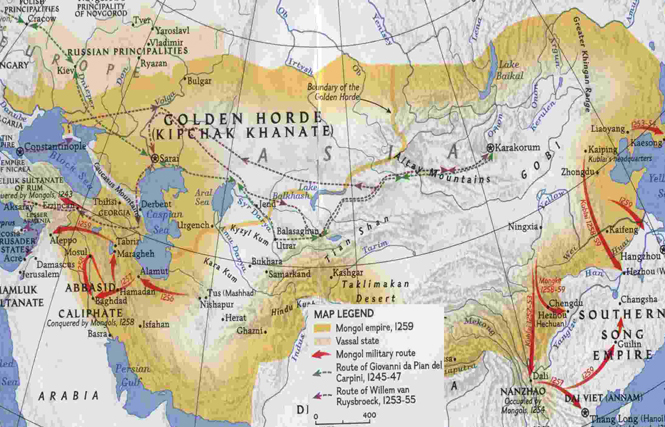
Mongolia is famous for its heritage of ancient history in the world. The historic heritage of Mongolia is mainly related to Chinggis Khaan, the warrior-statesman, who in the 13th century, united the Mongolian people into a strong nation and conquered a swath of the world from modern-day Korea to southern Russia and in invading deep into Europe, and the cultural achievements of his grandson, Khubilai Khan, in China are well-known in world history.
In 1206, Temuujin became Chinggis Khaan, the great khaan of the Mongols, having succeeded in rallying to his person all the dispersed Mongol and Turkish tribes, and having destroyed his powerful enemies, the Tatars, the Khereid, and the Naiman, and their entire race was scattered like ashes. Three phases were notable in the years after the 1206 coronation.
The first phases included the initial invasion during Chinggis Khaan's lifetime: 1206 to 1227 (one of the assumed dates of his death). In this period, the Mongols swept over north China, taking Daidu (as Beijing was then called), attaching and defeating the sultan of the Khwarezm who ruled over a large part of the Central Asia (Uzbekistan, Tajikistan, Turkmenistan, Afghanistan, and most of Iran), capturing Samarqand and Bukhara, before crossing the Caucasus and defeating the Russians and the Qipqak Turkish in the Crimea.
The second phase, the period of consolidation, marked the expansion of the empire under the reign of Ugudei, third son and successor of the Chinggis Khaan, from 1229 to 1241. Ugudei finished the conquest of North China (1229-1234) and destroyed the Jin dynasty.
After the collapse of the empire, Mongolia was subjugated by Manchu dynasty for 200 hundred years, and then in 1911 the Mongols Monarchy was established. The struggle of D.Sukhbaatar and his fellow revolutionaries against the Manchu brought about complete political and territorial independence in 1921. As the result of the Mongolian People’s revolution in 1921, Mongolia was released from Manchu colonization. It was dark years under the oppression of Manchu that had made Mongolia left behind world development.
The victory of People’s revolution enabled the country to embark on a new course of development, focusing on strengthening the state independence of Mongolia. During the period from 1921 to 1924, the new government carried out important changes in the political, economical, social spheres of the limited monarchy of Mongolia. In 1990’s, Mongolia transferred to Free Market economy and Democracy, and set the goal of building “democratic human socialism” based on a multi-party democracy. The great civilization started with the support of Soviet Union. In January 1992, a new constitution was established. The first President of Mongolia was elected by public election in 1993, which was very new to the people that they actually had the opportunity to choose their own leader. The president is elected for a four year term. Mongolia elects the Parliament on national level. The State Great Assembly, the parliament has 76 members, elected for a four year term in single-seat constituencies. Heavy industries, power plants, secondary schools, railways, telephone stations and telegraph lines have been built. A number of people increased who settled in major big cities such as Ulaanbaatar, Darkhan, Erdenet and Dornod.
